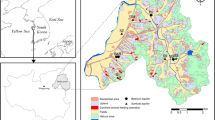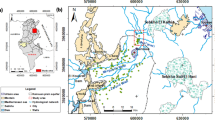Abstract
Of all groundwater pollution sources, septic systems are the second largest source of groundwater nitrate contamination in USA. This study investigated shallow groundwater (SGW) nutrient dynamics in septic areas at the northern part of the Lower St. Johns River Basin, Florida, USA. Thirty-five SGW-monitoring wells, located at nine different urban areas served by septic systems, were used to collect the SGW samples seasonally and/or biweekly for a duration of 3 years from 2003 to 2006. Analytical results showed that there were 16 wells with nitrate concentrations exceeding the US Environmental Protection Agency's drinking water limit (10 mg L−1). There also were 11 and 14 wells with total Kjeldahl nitrogen (TKN) and total phosphorus (TP) concentrations, respectively, exceeding the ambient water quality criteria (0.9 mg L−1 for TKN and 0.04 mg L−1 for TP) recommended for rivers and streams in nutrient Ecoregion XII (Southeast USA). In general, site variations are much greater than seasonal variations in SGW nutrient concentrations. A negative correlation existed between nitrate/nitrite–nitrogen (NOx–N) and TKN as well as between NOx–N and ammonium (\( NH_4^{ + } \)), whereas a positive correlation occurred between TKN and\( NH_4^{ + } \). Furthermore, a positive correlation was found between reduction and oxidation (redox) potential and water level, while no correlation was observed between potassium concentration and redox potential. This study demonstrates a need to investigate the potential adverse impacts of SGW nutrients from the septic areas upon the deeper groundwater quality due to the nutrient penetration and upon the surface water quality due to the nutrient discharge.











Similar content being viewed by others
References
Arnade, L. J. (1999). Seasonal correlation of well contamination and septic tank distance. Ground Water, 37, 920–923.
Braskerud, B.C., Hartnik, T., Løvstad, O. (2003). The effect of the redox-potential on the retention of phosphorus in a small constructed wetland. Diffuse Pollution Conference Dublin 3H: Agriculture, 3-170.
Capone, D. G., & Bautista, M. F. (1985). A groundwater source of nitrate in nearshore marine sediments. Nature, 313, 214–216.
Capone, D. G., & Slater, J. M. (1990). Interannual patterns of water table height and groundwater derived nitrate in nearshore sediments. Biogeochemistry, 10, 277–288.
Canter, L. W., & Knox, R. C. (1985). Septic tank system effects on groundwater quality. Chelsea, MI: Lewis.
DeWalle, F. B. (1981). Failure analysis of large septic tank systems. Journal of Environmental Engineering, 107, 229–240.
Durell, G.S., Seavey, J.A., Higman, J. (2001). Sediment quality in the Lower St. Johns River and Cedar-Ortega River Basin: Chemical contaminant characteristics. Battelle, 397 Washington Street, Duxbury, MA 02332.
Griffioen, J. (2001). Potassium adsorption ratios as an indicator for the fate of agricultural potassium in groundwater. Journal of Hydrology, 254, 244–254.
Kaplan, O. B. (1987). Septic systems handbook. Chelsea, MI: Lewis.
Lapointe, B. E., O'Connell, J. D., & Garrett, G. S. (1990). Nutrient couplings between onsite sewage disposal systems, groundwaters, and nearshore surface waters of the Florida Keys. Biogeochemistry, 10, 289–307.
Lapointe, B. E., & O'Connell, J. D. (1989). Nutrient-enhanced growth of Cladophora prolifera in brackish tidal marshes of Chesapeake Bay. Estuarine, Coastal and Shelf Science, 21, 45–55.
LBG, (Legget, Brashears, & Graham) Inc. (2004). Quantification of the role of shallow groundwater nutrient enrichment on exporting nutrient into the Lower St. Johns River Basin. St. Johns River Water Management District, Palatka, FL 32177.
Maruyama, T., Noto, F., Takimoto, H., Nakamura, K., Yoshida, M., Onishi, T., & Kawasima, S. (2011). Assessment of long-term changes in nitrogen pollution load potential from sewage treatment water in the Tedori River Alluvial Fan Area, Japan. Paddy and Water Environment, 9, 451–459.
SJRWMD (St. Johns River Water Management District) (2010). Field standard operating procedures for surface water sampling. St. Johns River Water Management District, 4049 Reid Street, Palatka, FL 32177. (386) 329-4500.
Valiela, I., & Teal, J. M. (1979). The nitrogen budget of a salt marsh ecosystem. Nature, 280, 652–656.
U.S. Census Bureau (2003). American housing survey for the United States: 1999. U.S. Census Bureau, Washington, DC. http://www.census.gov/hhes/www/housing/ahs/ahs99/tabla4.html. Verified 11 May 2004.
U.S. EPA (2002). Onsite wastewater treatment systems manual. EPA/625/R-00/008. USEPA, Office of Water, Washington, DC.
Wicklein, S. (2004). Evaluation of water quality for two St. Johns River tributaries receiving septic tank effluent, Duval County, Florida. U.S. Geological Survey, Water-Resources Investigations Report 03-4299, USGS, 2010 Levy Avenue, Tallahassee, FL 32301.
Acknowledgment
The authors thank their colleagues from the St. Johns River Water Management for their valuable comments and suggestions.
Author information
Authors and Affiliations
Corresponding author
Rights and permissions
About this article
Cite this article
Ouyang, Y., Zhang, JE. Quantification of Shallow Groundwater Nutrient Dynamics in Septic Areas. Water Air Soil Pollut 223, 3181–3193 (2012). https://doi.org/10.1007/s11270-012-1100-1
Received:
Accepted:
Published:
Issue Date:
DOI: https://doi.org/10.1007/s11270-012-1100-1




